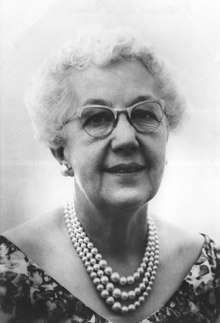Katherine Van Winkle Palmer
Katherine Van Winkle Palmer (1895 – September 12, 1982) was a Tertiary paleontologist, a scientist who studies fossils from the Cenozoic Era, and geologist.[1] Palmer was recognized for her field/doctoral study on veneracean lamellibranches,[1] a class of bivalve mollusks that include clams, scallops and oysters. Palmer was a director of the Paleontological Research Institution in New York.[2] At this position, Palmer oversaw the publication of numerous Bulletins of American Paleontology as well as several issues of Palaeontographica Americana.[2]
Katherine Van Winkle Palmer | |
|---|---|
 | |
| Alma mater | |
| Scientific career | |
| Fields | Paleontology |
Early life
Palmer was born to Jacob Van Winkle and Edith Van Winkle in Oakville, Washington, where she spent her youth.[3] In 1918, she received her bachelor of science degree at the University of Washington,.[1] She was a member of the Alpha Delta Pi chapter.[4] She wrote her thesis on the Oligocene fossils found in the Chehalis Valley in Washington.[2] At the University of Washington, she worked as the laboratory assistant to Charles E. Weaver, who focused his study on Tertiary fauna.[3] After graduation, Palmer continued her education at Cornell University where she received her Ph.D in 1925. During her studies there, Palmer met and married Ephraim L. Palmer, who was a Professor of Rural Education and Nature Study.[3] At Cornell, Palmer worked closely with professor Gilbert Harris, helping him create the Paleontological Research Institution.[2]
Career
Palmer and Harris established the Paleontological Research Institution (PRI) together in 1932, and in 1952 she replaced Harris as director, a post she occupied until 1978.[2] While at this position, Palmer oversaw the publication of 150 Bulletins of American Paleontology as well as 20 issues of Palaeontographica Americana.[2] As well as founding and overseeing the two publications, Palmer was a life trustee of both.[1] The same year that Palmer died (1982), she published the first history of the PRI,[3] securing her own, as well as the PRI's, legacy in print. Palmer's research produced more than 150 publications, including Gastropoda of the Claibornian Mid-Eocene of the Southern United States (1937), The Mollusca of the Jackson Eocene of the Mississippi Embayment (Sabine River to Alabama River) (1946), and Catalogue of the Paleocene, and Eocene Mollusca of the Southern and Eastern United States (1965), to name a few.[2] As well as conducting field studies in the United States, Palmer conducted research in the Gulf of Mexico, New Zealand, and the West Indies.[1] In 1935, Palmer was appointed Fellow of the Geological Society of America. Palmer was also president of the Malacological Society, an organization dedicated to the research and preservation of mollusks.[5] Palmer received the Paleontological Society Medal in 1972 as well as the Western Society of Malacologists Award in 1974 in honour of her lifelong contribution to geology.[1]
Awards and honors[6]
- National Honorary Member of Sigma Delta Epsilon/Graduate Women in Science (SDE/GWIS) (1971)
- Fellow of the Geological Society of America (1935)
- Honorary Member of the Society of Economic Paleontologists and Mineralogists (1966)
- First female recipient of the Paleontological Society Medal in 1972 for her work on Tertiary Mollusca: widely acknowledged as paleontology’s highest professional honor in the United States (1972)
- Western Society of Malacologists Award (1974)
- The Alpha Chapter of SDE/GWIS named their first Award for Excellence after Palmer (1978)
- The Katherine Palmer Award for amateur contributions to paleontology is presented each year by the Paleontological Research Institution (1993)
- "Paleontology is Alive and Well: A Symposium in Honor of Dr. Katherine Van Winkle Palmer" was held at Tulane University in 1978, which included an Honorary Doctor of Science presentation from the University (1978)
- Honorary Life Member of the American Malacological Union
References
- Caster, Kenneth E. (1983). "Memorial to Katherine Van Winkle Palmer". Journal of Paleontology. 57 (5): 1141–1144. JSTOR 1304780. (reprinted in Geological Society Memorials 17:1-4. 1986
- Armentrout, John M., ed. (1981). Pacific Northwest Cenozoic Biostratigraphy. Special Paper. 184. Geological Society of America. p. iv. ISBN 978-0-8137-2184-2.
- "Abstract: Katherine Van Winkle Palmer (1895-1982): The Lady and Her Fossils (GSA Annual Meeting in Denver, Colorado, USA - 2016)". gsa.confex.com. Retrieved 2016-11-18.
- The Adelphean of Alpha Delta Pi, April 1921, vol. 13(2), p. 135.
- "About American Malacological Society". www.malacological.org. Retrieved 2016-11-24.
- Cannon, Max. "The Gertrud Wolfner PRI Archives - Katherine V. W. Palmer, 1895–2002". archives.priweb.org. Retrieved 2016-11-26.